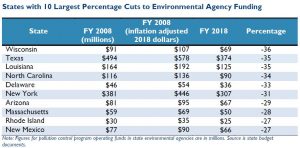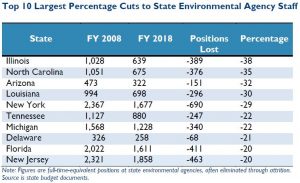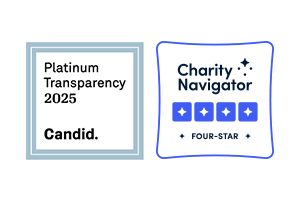Rhetoric about Shift from EPA to States Conflicts with Reality that States Cut 4,400 Pollution Control Staff
For audio of the December 5 press teleconference, click here.
Washington D.C. – During a decade of cuts at EPA fueled by rhetoric that environmental responsibility should be shifted from the federal to state level, 30 states cut funding for their own environmental agencies and 40 reduced their staffing, according to a new study of state budget records.
The nonpartisan Environmental Integrity Project’s report, “The Thin Green Line: Cuts to State Pollution Control Agencies Threaten Public Health,” examined spending and staffing in state pollution control programs in the lower 48 U.S. states from 2008 to 2018.
“The Trump Administration has been trying to roll back EPA’s authority and funding by arguing that the states will pick up the slack and keep our air and water clean,” said Eric Schaeffer, Executive Director of the Environmental Integrity Project.
“This is just a shell game, however,” said Schaeffer, former Director of Civil Enforcement at EPA, “because state agencies are often badly understaffed and the EPA workforce is already at its lowest level in more than thirty years. Neither EPA nor states have the funding they need to meet their responsibilities under the Clean Air Act, Clean Water Act and other laws that protect the public’s health and our environment from dangerous pollution.”
The White House and Congress reduced EPA’s funding and staffing for pollution control and science programs by 16 percent from 2008 to 2018, when adjusted for inflation. During this period, many states slashed their own environmental agency funding by an even greater percentage—notably Texas (35 percent), North Carolina (34 percent), and Illinois (25 percent). The reductions in these state environmental programs came even though state spending was growing overall, and environmental threats were rising, including a booming oil and gas industry and climate change.
Luke Metzger, Executive Director of Environment Texas, said: “With one-third of our waterways unsafe for fishing and swimming and two-thirds of Texans living in areas with unsafe air quality, Texas has major environmental problems. But instead of meeting this challenge, our legislature is deprioritizing the environment and public health.”
The steep reductions at state environmental agencies came despite evidence that many environmental violations are resulting in no enforcement or penalties.
For example, EPA records show there are 2,098 sewage plants, factories, and other industrial sites across the U.S. that are currently in significant violation of federal air, water, or hazardous waste pollution control laws, including 1,255 that have been in violation every quarter continuously for the last three years. Of these 1,255 sites with chronic violations, 80 percent (1,008) are in states with environmental agencies that have suffered staffing cuts, records show.
The Environmental Integrity Project (EIP) examination of state budget records from 2008 to 2018 (adjusted for inflation) found:
- Thirty states reduced the funding for their environmental agencies’ pollution control programs. Twenty-five states imposed cuts of at least 10 percent on their environmental agencies. Sixteen states reduced spending by more than 20 percent, when adjusted for inflation.
- Although coastal flooding driven by climate change is increasing, six of the 10 states with the sharpest cuts to their environmental agencies are coastal states that are disproportionately hurt by rising sea levels, including North Carolina, Louisiana, and New York.
- Forty states reduced the staffing levels at their environmental agencies over this decade. Twenty-one states cut their environmental workforce by at least 10 percent, and nine by 20 percent or more.
- Overall, states eliminated 4,400 positions at agencies responsible for protecting the environment.
In many cases, the cuts were not the result of state budget crunches but deliberate policy choices. Several states slashed spending on their environmental agencies while their overall state budget grew significantly. For example, between 2008 and 2018, after adjusting for inflation Texas cut the funding its state Commission on Environmental Quality by 35 percent, while boosting overall state government spending by 41 percent. Researchers found similar trends in Indiana, Pennsylvania, and North Carolina.
 Reactions from State Environmental Advocates:
Reactions from State Environmental Advocates:
North Carolina: Drew Ball, Director of Environment North Carolina, said: “This idea that we can just slowly underfund our state environmental agencies, and that is somehow going to be beneficial to the state or business is just really backward. It doesn’t help business and certainly doesn’t help the health and safety of families.”
Louisiana: Anne Rolfes, Director of the Louisiana Bucket Brigade, an environmental organization, said: “The Louisiana Department of Environmental Quality needs two things: more money in its budget and the will to enforce the law. Demoralized employees lack the proper funding to do their jobs, and they are vulnerable to industry pressure.”
Illinois: Jen Walling, Executive Director of the nonprofit Illinois Environmental Council, said: “I know the people at IEPA are trying to do their jobs and the obligations we’ve given them with limited resources, but it’s just too little and the work isn’t getting done. This means that people are subject to more pollution, polluters are getting away with more violations, and also, for industry, it takes longer to obtain a permit in Illinois.”
Indiana: Dr. Indra Frank, Environmental Health and Water Policy Director at the Hoosier Environmental Council, said: “There are many smart, hard-working people at Indiana’s Department of Environmental Management, but their ability to do the work the state needs is curtailed by severe resource limitations and repeated budget cuts.”
Pennsylvania: David Masur, Director of PennEnvironment, a nonprofit advocacy organization, said: “From soup to nuts, when you make steep cuts in revenue at the Pennsylvania Department of Environmental Protection and then lose staff and expertise, not surprisingly, your ability to run the agency and protect the environment is chopped off at the knees.”
 Policy Recommendations:
Policy Recommendations:
1) Industry lobbyists and politicians should stop pretending that shifting more responsibility for environmental programs from federal to state agencies won’t tear big holes in the safety net that protects public health. This is a fallacy when most state environmental agencies have been weakened by budget and workforce cuts.
2) Governors and state lawmakers should fund state environmental agencies sufficiently to allow them to hire enough inspectors, permit writers, scientists, engineers, and other professionals to implement federal laws that protect public health, clean air, and clean water. That should be done by increasing permitting fees for industry that most states already collect.
3) Neither EPA nor most state environmental agencies have enough funding to perform their responsibilities. Congress could help with more funding for both EPA and state agencies. However, any increases for the states should not be taken out of EPA operating programs, because EPA’s workforce has already shrunken to levels not seen since the Reagan Administration.
Interactive Map with Budget and Staffing Data for All 48 Lower U.S. States:
Click legend [>>] to toggle between spending changes and staffing changes. Click [>] within legend to view percent changes corresponding to each color: blue means increase in spending or staffing; yellow, orange or red means decrease.
Note: The 2008 spending figure for Indiana is actually an average of spending from 2007 to 2009. The average more realistically represents spending levels, as 2008 was an anomalous year for Indiana due to a spike in federal funding.
###
The Environmental Integrity Project is a nonprofit, nonpartisan organization based in Washington, D.C., and Austin, Texas, that protects public health and the environment by investigating polluters, holding them accountable under the law, and strengthening public policy.
Media contact: Tom Pelton, Environmental Integrity Project (443) 510-2574 or tpelton@environmentalintegrity.org


